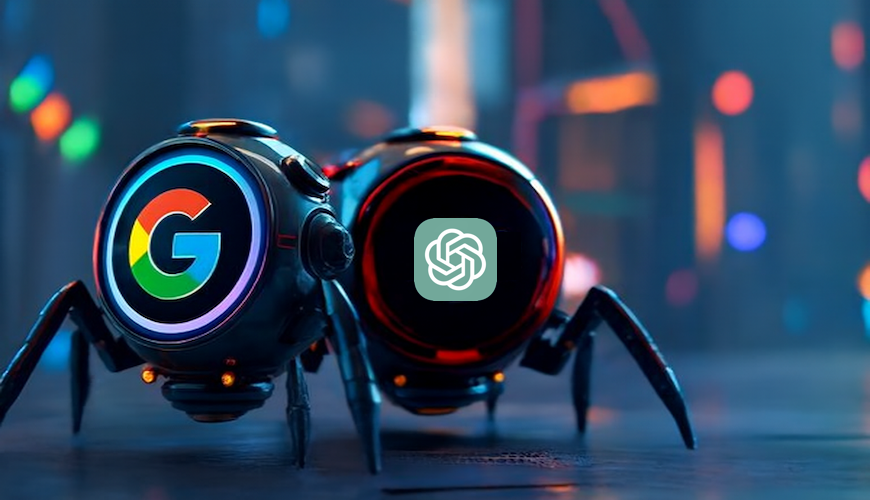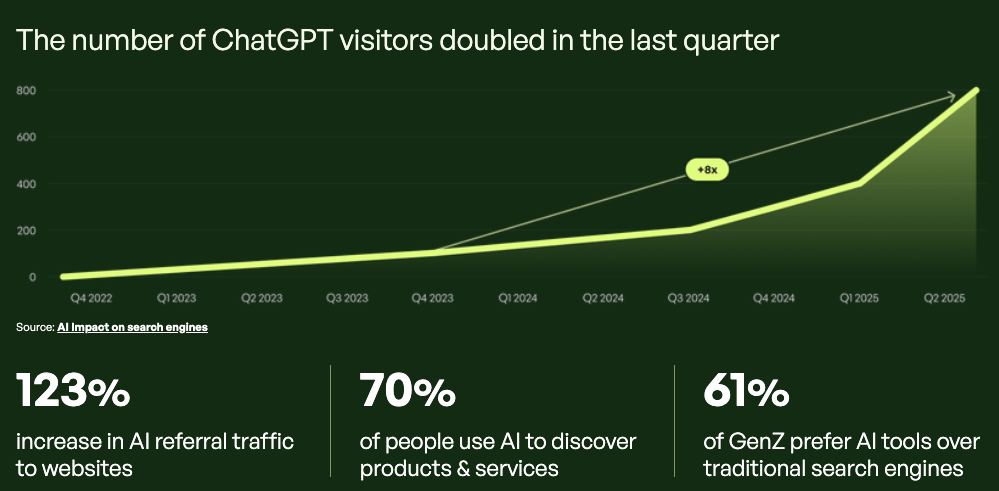


Imagine you’re fishing in a lake. Traditional fishing rods work well when you’re trying to hook individual fish. But now, the lake has changed. Instead of baiting fish with hooks, many have switched to casting wide nets designed to sweep through and gather everything the currents bring within their reach. Both approaches—rod and net—catch fish, but they require different techniques.
This is the shift happening with how we handle online visibility. Traditional Search Engine Optimization (SEO) represents the fishing rod—a precise strategy designed to attract specific users to click and visit your website. Meanwhile, Artificial Intelligence Optimization (also referred to as GenAI or Answer Engine Optimization) is the wide net, ensuring your content is captured and reused in AI-powered tools that synthesize and deliver answers directly, often skipping the need for a website visit altogether.
But here’s the catch—these two methods aren’t competing. They work best when combined. By maintaining your SEO strategies and adding AEO, you ensure the full spectrum of visibility in today's evolving search landscape.
This article breaks down the similarities and differences between SEO and AEO, explains why AEO is no longer optional, and provides steps to help you lead in this new age of AI-powered answers.
Before we explore the differences, it’s important to understand how SEO and AEO complement each other. Both aim to make content visible, valuable, and accessible to their respective audiences—humans and machines alike.
✓ Shared goals:
Improving visibility. SEO strives to rank content on search engine results pages (SERPs), while AEO works to ensure content is surfaced in AI-generated answers. Both approaches aim to put your content in front of users where it matters most.
Delivering relevance. Whether someone is searching for "best winter jackets under $200" or asking an AI tool for recommendations, both strategies depend on understanding and addressing user intent.
Providing real value. High-quality content, rich with useful information, is a requirement for both SEO and AEO. The ultimate goal is to ensure the user—whether human or AI—finds the answer they need.
✓ Shared foundations:
Content excellence. Clear, well-researched, and engaging content is a shared pillar of SEO and AIO success.
Technical optimization. Fast-loading, mobile-friendly websites with clean code benefit both humans (for SEO) and machines (for AEO).
Understanding intent. Anticipating and addressing what users are searching for or asking ensures your content resonates across platforms.
These shared foundations illustrate why SEO and AEO are compatible strategies rather than competing priorities.
SEO and AEO share similar goals but approach them differently. While SEO focuses on optimizing for rankings, AEO focuses on preparing content to be used in machine-driven contexts.
Refer to our guide, What's Answer Engine Optimization, to learn more.
Primary Goal.
SEO → Rank high on search engine results pages (SERPs)
AEO → Be included in AI-generated answers
Audience.
SEO → Human users who click links
AEO → Humans and AI tools interpreting content
Focus Ares.
SEO → Keywords, backlinks, metadata
AEO → Entities, structure, clarity, citations
Success measures.
SEO → Clicks, traffic, engagement
AEO → Content reuse in zero-click AI responses
✓ Driving traffic
Gets people to your website via compelling snippets and search ranking
✓ Building authority
Earns trust over time through backlinks and consistent publishing
✓ Supporting long-term discovery
Keyword-rich content stays findable for months or years
✓ Optimizing for AI tools
Structured, machine-readable content makes you eligible for ChatGPT, Perplexity, and more
✓ Winning in zero-click scenarios
Keeps your brand visible even when users never leave the AI interface
✓ Future-ready
Aligns with how people search today—through voice, AI assistants, and direct answers
Scenario: You're creating a page for eco-friendly packaging.
With SEO. You target keywords like “biodegradable packaging for businesses,” build backlinks, and craft strong meta titles to attract clicks.
With AEO. You structure your content to highlight known entities (e.g., “compostable coffee cups,” “UK-based supplier”), apply clear schema, and present facts in scannable blocks.
Result? AI tools can pull your product info directly into an answer—no click required.
SEO gets you to the top of the rankings. AEO gets you reused. Both matter—but in the GenAI era, being part of the answer is just as important as being found.

With AI answer engines driving millions of daily interactions, AEO has shifted from a “nice-to-have” to a must-have strategy for maintaining visibility. Here’s why ignoring AEO is no longer an option for businesses:
AI platforms like Google Bard or ChatGPT have replaced traditional web searches with dynamic conversations. Instead of browsing links for answers, users get instant responses synthesized from multiple sources. If your content isn’t tailored for this environment, it gets left out of the conversation.
Over half of searches today never lead to a click. Users are satisfied with AI-generated summaries or direct responses within the search interface. If your content isn’t optimized for these scenarios, it’s effectively invisible to this growing segment.
It’s like catching the wind before others raise their sails. Those who invest in AEO now are more likely to become trusted, front-of-mind sources in AI answers—and they’ll stay ahead as competitors race to adjust.
Businesses that fail to adapt will see diminishing returns from SEO alone. By ignoring AEO:
Failing to adopt AEO isn’t just a missed opportunity; it’s a step toward irrelevance. Your content risks being lost in the growing sea of AI-powered digital conversations.
Not all KPIs translate to the AI era. When visibility doesn’t always lead to clicks, it’s time to rethink how we measure performance. The KPIs below are grouped to help you understand how AI tools find your content, decide whether to use it, and determine if your brand is worth mentioning. Each group reflects a different stage in how machines process and surface your information.
These metrics are about whether your content is even in the running to be used by AI.
These show how your content is reused in AI-generated answers.
These indicate how often your brand gets named or recognized in the answer.
This reflects your reputation and perceived authority from an AI's point of view.
You don’t need to abandon your SEO playbook to embrace AEO—you build on it. Here’s how to get started:
As user behavior shifts and AI tools become the first stop for answers, the gap between being visible and being used is growing fast. Combining SEO with AEO gives your brand an edge where it counts: inside the answers users actually see.
If your competitors are optimizing for AI and you’re not, you’re handing them the spotlight. Don’t just publish content. Make it unavoidable. Act now and position your brand at the center of the new search experience.
Try reaching out to an AEO agency for guidance, or start small on your own using the available resources. Don’t miss the opportunity to appear in AI-generated answers—this is the future of search.